Over the past few years, digital pianos and keyboard pianos have gained increasing popularity as technology has developed to create an authentic acoustic piano experience and sound.
Without the weight and lack of portability associated with a traditional upright or grand piano, keyboards provide musicians with the flexibility to perform from almost anywhere.
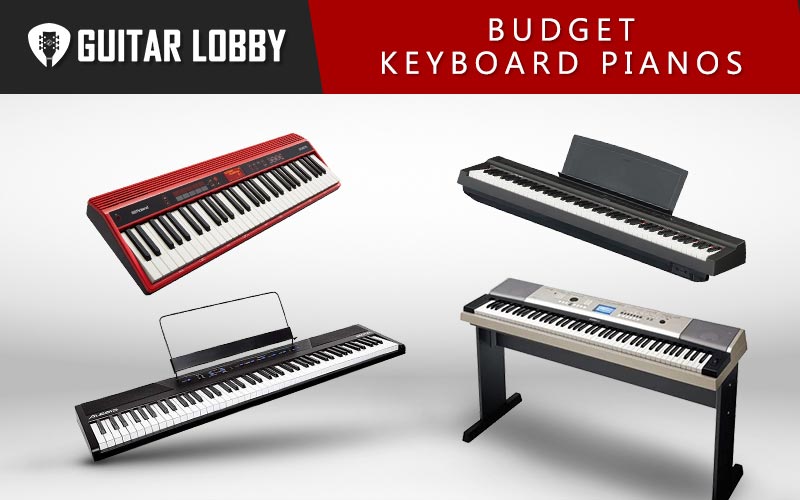
Whether you’re a beginner looking to buy your first keyboard piano or an experienced pianist looking for a more portable instrument, there’s a good option out there for you. I’ll start this guide by jumping into reviews on some of the best cheap keyboard pianos, but if you want to learn more before reading reviews, I put together an information guide on the bottom of the page here that will cover everything you could ever want to know before purchasing a piano.
| Name of Product | Image of Product | Description | Price Range | Full Review |
|---|---|---|---|---|
| 1. Yamaha P-45 Digital Piano (Best Value) |  | Key Count: 88 Weighted Keys: Yes | $500 | Read Full Review Below |
| 2. Alesis Recital 88-Key Digital Piano (Best Under $300) | 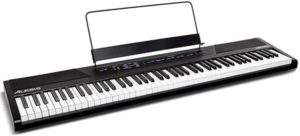 | Key Count: 88 Weighted Keys: Semi | $300 | Read Full Review Below |
| 3. Casio CTK-3500 (Best Under $200) | 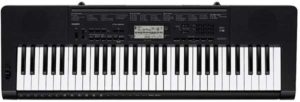 | Key Count: 61 Weighted Keys: Semi | $170 | Read Full Review Below |
| 4. Casio Privia PX-160 Digital Piano (Editor's Choice) | 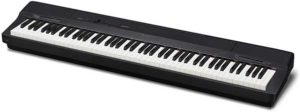 | Key Count: 88 Weighted Keys: Yes | $550 | Read Full Review Below |
| 5. Roland FP-10 Digital Piano (Best Value) |  | Key Count: 88 Weighted Keys: Yes | $500 | Read Full Review Below |
| 6. Kawai ES110 |  | Key Count: 88 Weighted Keys: Yes | $700 | Read Full Review Below |
| 7. Yamaha P-125 | 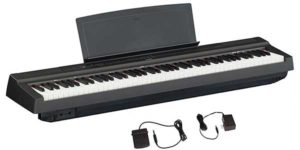 | Key Count: 88 Weighted Keys: Yes | $650 | Read Full Review Below |
| 8. Casio PX-S1000 |  | Key Count: 88 Weighted Keys: Yes | $650 | Read Full Review Below |
| 9. Yamaha YPG-535 | 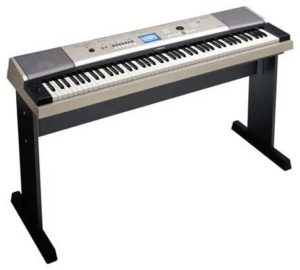 | Key Count: 88 Weighted Keys: Semi | $550 | Read Full Review Below |
| 10. Korg B1 |  | Key Count: 88 Weighted Keys: Yes | $500 | Read Full Review Below |
| 11. Medeli SP4200 | 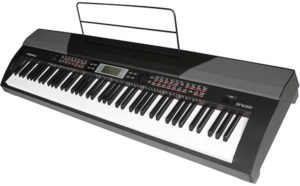 | Key Count: 88 Weighted Keys: Yes | $500 | Read Full Review Below |
| 12. Yamaha P71 | 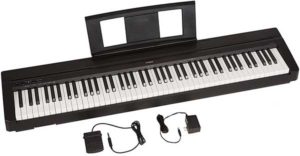 | Key Count: 88 Weighted Keys: Yes | $450 | Read Full Review Below |
| 13. Roland GO:PIANO88 | 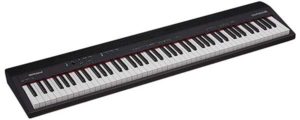 | Key Count: 88 Weighted Keys: Three touch sensitivity levels | $400 | Read Full Review Below |
| 14. Artesia PE-88 | 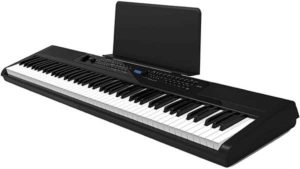 | Key Count: 88 Weighted Keys: Five touch sensitivity options | $300 | Read Full Review Below |
| 15. Artesia Performer |  | Key Count: 88 Weighted Keys: Semi | $210 | Read Full Review Below |
| 16. Roland GO:KEYS |  | Key Count: 61 Weighted Keys: No | $330 | Read Full Review Below |
| 17. Yamaha PSR-EW300 | 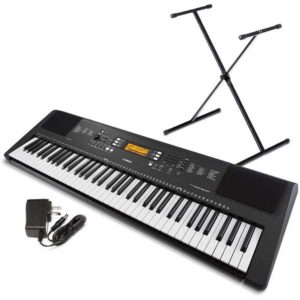 | Key Count: 76 Weighted Keys: No | $270 | Read Full Review Below |
| 18. Casio WK-245 | 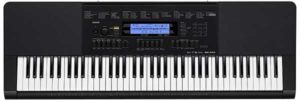 | Key Count: 76 Weighted Keys: No | $230 | Read Full Review Below |
Here Are the Best Cheap Keyboard Pianos
1. Yamaha P-45 Digital Piano (Best Value)

| Estimated Price | $500 |
| Weight | 25.6 pounds |
| Size Dimensions | 52.2” x 6.1” x 11.6” |
| Keys | 88-key Graded Hammer Standard action |
| Touch Sensitivity | Four Levels |
| Polyphony | 64 notes |
My Review: The P-45 is one of Yamaha’s best selling digital pianos in the world and is the only model from the brand that you can buy for under $500. My favorite feature of this keyboard piano is the Graded Hammer Standard keys. This weighted action is heavier in the lower keys and lighter at the higher keys giving the natural feel of an acoustic piano. The P-45 also features Yamaha’s AWM (Advanced Wave Memory) stereo sampling technology to provide you with a quality, realistic piano sound. This model does lack many of the features other models in its class offer and does not include line out ports, but is an ideal keyboard piano for those looking to develop their skills. Overall, a solid keyboard piano for beginners and those who want a solid keyboard to play at home.
Who Will Use This Most: A great keyboard piano for musicians who grew up playing an acoustic piano but don’t have the room or budget for one now. This is a great model to choose if you’re looking for a portable piano that provides quality sound and authentic playing experience.
Bottom Line: The P-45 is the perfect choice for beginners and hobbyists who are looking for a simple, quality keyboard piano that will replicate the playing experience of an acoustic piano. This is also a great keyboard for musicians that want the Yamaha sound quality without paying for the more expensive models. After owning and testing dozens of keyboards over the years, I would say the Yamaha P-45 best keyboard piano under 500 dollars.
YouTube Review:

2. Alesis Recital 88-Key Digital Piano (Best Under $300)
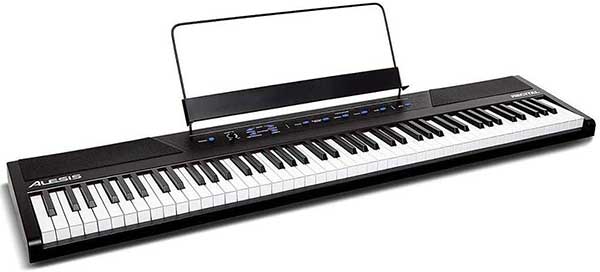
| Estimated Price | $220 |
| Weight | 15.62 pounds |
| Size Dimensions | 3.6” x 11.52” x 50.52” |
| Keys | 88 semi-weighted keys |
| Touch Sensitivity | Adjustable touch response |
| Polyphony | 128 notes |
My Review: The Alesis Recital 88-key digital piano is marketed for beginners, but it’s a full-sized keyboard with quality sound that won’t empty your bank account, which is why I’ve listed it as the “Best Keyboard Piano Under $300.” This digital piano features semi-weighted keys that are reminiscent of an acoustic piano and feel much better than the unweighted keys most keyboards in this price range offer. Featuring five quality built-in voices, a Layer Mode that allows you to combine any two voices at once, and a Split Mode that allows you to assign voices to only the left or right hand, Recital delivers great value for its price.
Who Will Use This Most: Alesis Recital is a great starter keyboard piano for anyone looking to get back into playing the piano or for those looking to learn. It’s a great option for musicians on a tight budget looking for an instrument to practice and develop their sound. You won’t be playing festivals with this keyboard, but it’ll definitely tide you over until you’re ready to invest further.
Bottom Line: Probably the best full-sized keyboard you’ll find under $300. It’s got quality sound, semi-weighted keys, and 20W speakers, all at a price that can’t be beat. This is our favorite keyboard piano under 300 dollars.
YouTube Review:

3. Casio CTK-3500 (Best Under $200)
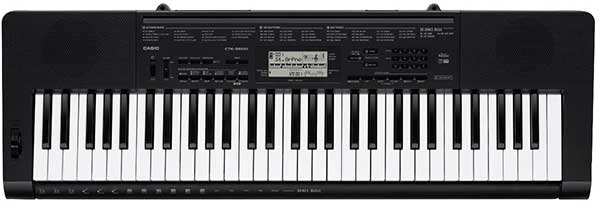
| Estimated Price | $170 |
| Weight | 7.5 pounds |
| Size Dimensions | 37.24” x 3.62” x 12.09” |
| Keys | 61-key semi-weighted keyboard with spring action |
| Touch Sensitivity | Two levels of touch sensitivity |
| Polyphony | 48 notes |
My Review: This keyboard piano is a great choice for aspiring pianists and keyboard players on a budget. The Step-Up Lesson System will teach you the basics of piano playing and the built-in LCD display screen will help you learn correct hand positioning and music notation. The Casio CTK-3500 is also compatible with the Chordana Play app, which offers more educational features. Due to its Bluetooth capability and optional battery power, this keyboard is fully portable and allows you to play anywhere at any time. The downsides to this instrument are that its lack of weighted keys and that it only includes 61 keys.
Who Will Use This Most: This keyboard piano is a great option for aspiring musicians looking to learn piano on a budget. It doesn’t have weighted keys or a full-sized keyboard so you won’t get an authentic acoustic piano experience, but it’s a good instrument to use to start learning the basics. This is a great value keyboard and it’s built-in Step-up Lessons System will help you jumpstart your piano playing abilities.
Bottom Line: If you’re on a tight budget but want need a keyboard piano to start learning on, this is a good choice. This instrument will do to start off with, but you’ll eventually need to upgrade to a full-sized keyboard to truly develop your skills. This is easily one of the best budget keyboard pianos out there.

4. Casio Privia PX-160 Digital Piano (Editor’s Choice)
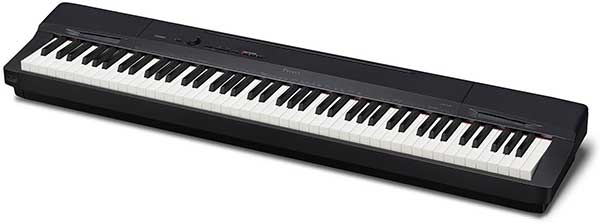
| Estimated Price | $550 |
| Weight | 25.5 pounds |
| Size Dimensions | 52” x 11.5” x 5.6” |
| Keys | 88-key Tri-Sensor Scaled Hammer Action II (graded hammer action) keyboard for authentic piano experience |
| Touch Sensitivity | Three touch response sensitivity levels |
| Polyphony | 128 notes |
My Review: This keyboard piano constantly wins out as one of the best keyboards for those on a budget. It’s Tri-Sensor Scaled Hammer Action II keyboard gives one of the most authentic playing experiences in the digital piano space. Not only does this keyboard piano have an incredible feel, but it also has the high-quality piano sound you’re looking for. Casio Privia PX-160 includes a built-in track recorder and 60 built-in songs for you to practice. This keyboard piano also features a “duet mode” that allows you to split the keyboard into two equal ranges, a great option for teachers and students. I also like that it has 18 built-in tones, including new string ensemble tones in addition to the grand piano, electric piano, and harpsichord sound options. If you’re looking to recreate the playing experience of an acoustic piano this is a great option for you.
Finish: Casio Privia PX-160 is available in a black or champagne gold finish.
Who Will Use This Most: Casio Privia PX-160 is a great keyboard piano for beginner, intermediate, and advanced players alike. This is the ideal keyboard for someone who is looking for a model that comes as close to playing an acoustic piano without the investment, weight, and lack of portability.
Bottom Line: This is a great, budget-friendly keyboard piano for musicians of all skill levels. If you’re looking to replicate the traditional piano playing experience, this keyboard delivers. This is easily one of the best cheap keyboard pianos on the market right now.
YouTube Review:

5. Roland FP-10 Digital Piano

| Estimated Price | $500 |
| Weight | 27.1 pounds |
| Size Dimensions | 50.5” x 10.1” x 5.5” |
| Keys | 88-key PHA-4 (Progressive Hammer Action) format |
| Touch Sensitivity | Adjustable touch sensitivity with five preset settings |
| Polyphony | 96 notes |
My Review: Roland’s FP-10 was designed with gigging in mind. It’s compact, affordable, sounds great, and plays great. It will be challenging to find another digital piano in this price range that has the sound quality the FP-10 offers. This keyboard piano features 88 fully weighted keys with PHA-4 (Progressive Hammer Action), which means each key is individually weighted, with the lower keys being heaviest and the higher keys becoming increasingly lighter.
The FP-10 keyboard piano also features Bluetooth connectivity, which allows you to connect with apps, like Piano Partner 2, and all Digital Audio Workstations (DAW). The biggest drawbacks to this keyboard piano are there are no dedicated Line Out jacks and the built-in speakers are not the most powerful. Otherwise, this is a great option for anyone who has to run from gig to gig and needs a reliable, quality keyboard to get them through. It has 15 built-in voices, including four grand pianos, two electric pianos, a jazz organ, a church organ, and more.
Who Will Use This Most: The portability, functionality, and sound quality of this keyboard piano make it ideal for gigging. The Roland FP-10 is also a great option for intermediate and advanced players looking for a portable, space-saving second piano.
Bottom Line: If you’ve been tempted by the Roland FP-Series but have held back due to the price, the FP-10 is the perfect match for you. It’d be difficult to find a comparable keyboard piano at this price that can rival Roland’s high-quality SuperNATURAL piano voice.
YouTube Review:

6. Kawai ES110

| Estimated Price | $700 |
| Weight | 26.5 pounds |
| Size Dimensions | 51.6” x 11.2” x 5.8” |
| Keys | 88-key fully weighted keyboard |
| Touch Sensitivity | Three touch sensitivity level |
| Polyphony | 192 notes |
My Review: This is the most expensive keyboard piano I’ve included on this list, but is probably one of the most popular models available under $1000. The Kawai ES110 is both compact and portable, making it an ideal instrument for musicians who are going back and forth between sessions and gigs and need an instrument that easily transports. This keyboard piano features Responsive Hammer Compact action that very closely mimics the feel of an acoustic piano and has graded hammers so that the lower notes are heavier than the higher notes. The Kawai ES110 uses the Harmonic Imaging sound engine, which samples each note of the Kawai 9-foot EX Concert Grand Piano to produce the most authentic sound possible. Overall this digital piano will give you a great playing experience and delivers rich piano tones that can be tailored to your preferences.
Finish: The Kawai ES110 comes in “stylish black” or “elegant white” finishes.
Who Will Use This Most: This keyboard piano is an excellent choice for established musicians that need a gig-friendly instrument. Its exceptional sound quality makes it an obvious choice for stage performers and the solid built-in speaker system has enough power on its own to produce clear audio in a small room. It’s also highly portable, which is another great feature for on-the-go musicians. If you’re looking to invest in a solid keyboard piano that will hold its value, this is a good instrument to consider.
Bottom Line: You’re getting an excellent value with this keyboard piano. It has great sound quality and its Responsive Hammer Compact action feels very similar to an acoustic grand piano. While it’s a higher price than most keyboard pianos on this list, you’ll get every bit of your money back in value.
YouTube Review:

7. Yamaha P-125
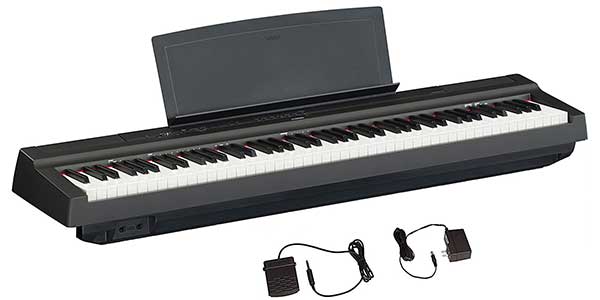
| Estimated Price | $650 |
| Weight | 26 pounds |
| Size Dimensions | 52.2” x 11.6” x 6.5” |
| Keys | 88-key fully weighted keyboard |
| Touch Sensitivity | Four touch sensitivity levels |
| Polyphony | 192 notes |
My Review: The Yamaha P-125 keyboard piano has is one of the best sounding models in its class. Its sound engine was designed around the acclaimed Yamaha CFIIIS concert grand piano providing a rich, authentic tone. Designed for pianists at every skill level, the P-125 delivers an authentic playing experience due to its fully weighted keybed and Graded Hammer Standard action. This user-friendly instrument is also compatible with the Smart Pianist app, bringing even more features and functionality to your practice. The only feature this keyboard is truly lacking is Bluetooth connectivity, but if that’s not an important feature for you, you can’t go wrong with this instrument.
Who Will Use This Most: Probably one of the best portable keyboard pianos in its price range, the Yamaha P-125 is a great choice for musicians looking for a quality, cost-effective instrument. Featuring a great speaker system, high-quality sound, and a strong selection of onboard effects, this keyboard is a good choice for pianists of all skill levels. Those who perform regularly and need a gig-friendly instrument will especially appreciate the features included in the P-125.
Bottom Line: If you’ve got the extra cash, the P-125 is a great option for beginners and advanced pianists alike. You’re sure to enjoy the playing experience and the sound quality alone makes it worth the higher price.
Youtube Review:

8. Casio PX-S1000

| Estimated Price | $650 |
| Weight | 24.7 pounds |
| Size Dimensions | 52” x 9.1” x 4” |
| Keys | 88-keys with Smart Scaled Hammer Action |
| Touch Sensitivity | Five adjustable touch sensitivity levels |
| Polyphony | 192 notes |
My Review: This keyboard piano is compact, lightweight, and built for stage performance. If you’ve got a little extra money to invest in your instrument, the Casio PX-S1000 is a great choice for you. This digital piano leverages Casio’s AiR (Acoustic and intelligent Resonator) sound engine to deliver a rich, vibrant acoustic piano tone. The high-quality sound combined with the weighted, Smart Scaled Hammer Action keyboard, delivers a perfect, portable substitute for an acoustic piano. The keyboard is also designed to work with the Chordana Play for Piano app (available for both Android and iOS) for additional features and sounds.
Finish: Casio PX-S1000 comes in black, white, or red finishes.
Who Will Use This Most: This compact, portable keyboard is a great choice for musicians who busk or gig regularly. It’s built-in speakers provide solid sound, but the keyboard also includes the necessary line out jacks for external mixing, amplification, or speaker systems. This keyboard can also run on batteries for up to four hours, which makes it the ideal option for a busker who doesn’t always have an electrical outlet to tap in to.
Bottom Line: If you can afford the extra hundred bucks and you’re looking for a keyboard to use at your next gig, the Casio PX-S1000 is a great option. Designed with on-the-go performances in mind, this keyboard piano has a great natural sound and has all the functionalities you need.
YouTube Review:

9. Yamaha YPG-535
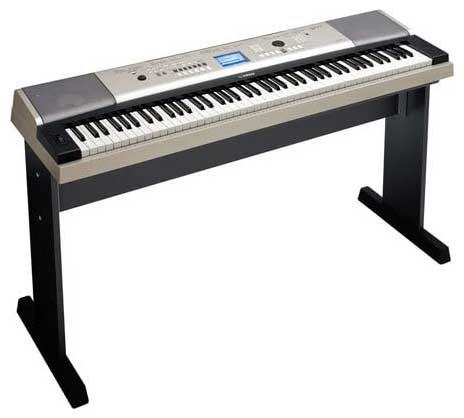
| Estimated Price | $550 |
| Weight | 24 pounds |
| Size Dimensions | 52.7” x 16.6” x 5.7” |
| Keys | 88-key semi-weighted keyboard with Graded Soft Touch action |
| Touch Sensitivity | Three touch sensitivity levels |
| Polyphony | 32 notes |
My Review: Part of Yamaha’s Portable Grand Series, the YPG-535 is packed full of features that are sure to stir your creative juices. A good instrument for both beginners and experts, this keyboard piano is extremely versatile and really becomes a tool for your creations. It includes the Yamaha Education Suite which offers interactive lessons, which is a great feature for beginners and includes several features for songwriting. The main drawback to the YPG-535 is its semi-weighted keys, which will not create the same feel as a real acoustic piano. This keyboard piano also only offers 32-note polyphony, which could be limiting for players looking to perform complex classical compositions or create multi-track recordings. If you’re not bothered by the semi-weighted keys or low polyphony, this instrument is a great option.
Who Will Use This Most: The YPG-535 is a great choice for established songwriters and those who are looking to try their hand a songwriting/composing alike. With features like Easy Song Arranger and 6-track MIDI recorder, this keyboard piano is designed to capture moments of inspiration at any time. With all these options at your fingertips, you’re sure to never be bored during your creative process.
Bottom Line: The Yamaha YPG-535 is one of the most popular keyboards for a reason. It’s a versatile instrument that offers a lot of bang for its buck. This keyboard piano also comes with a stand and sustain pedal, which makes it even more appealing.
Youtube Review:

10. Korg B1

| Estimated Price | $500 |
| Weight | 26. o1 pounds |
| Size Dimensions | 51.65” x 13.23” x 4.61” |
| Keys | 88-key weighted keyboard with natural weighted action |
| Touch Sensitivity | Three touch sensitivity level |
| Polyphony | 120 notes |
My Review: The Korg B1 is a simple, straightforward digital piano. It’s designed specifically for pianists who are looking for a portable acoustic piano alternative and nothing more. This keyboard piano does not offer a lot of extra features but does a great job delivering on the acoustic piano feel and sound. Featuring an 88-key hammer-action keyboard, eight authentic instrument voices, and a high-quality sustain pedal included in the price of the purchase, the Korg B1 will satisfy your basic piano needs at a manageable price.
Who Will Use This Most: This keyboard piano is ideal for a student away at college who needs a portable, compact instrument. It would also work for gigs, though it does lack some of the features needed for live performance. The Korg B1 is a good option for students and hobbyists that would like to easily transport their instrument from one place to another.
Bottom Line: This keyboard was designed with simplicity in mind and doesn’t include a lot of extra bells and whistles. If you’re simply looking for an acoustic piano alternative, the Korg B1 keyboard piano is the right choice for you.
YouTube Review:

11. Medeli SP4200
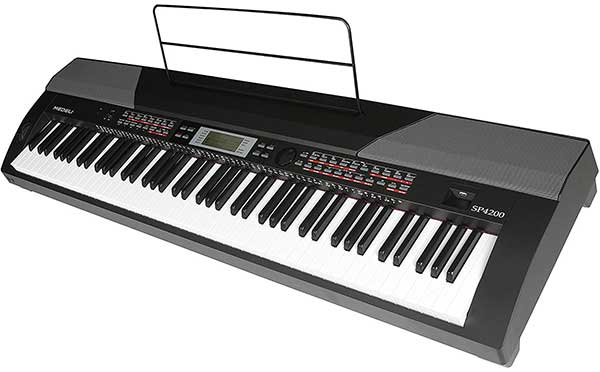
| Estimated Price | $500 |
| Weight | 30.42 pounds |
| Size Dimensions | 53.74” x 14.40” x 5.39” |
| Keys | 88-key weighted keyboard with hammer action |
| Touch Sensitivity | Three touch sensitivity levels |
| Polyphony | 128 notes |
My Review: The Medeli SP4200 keyboard piano is a solid option for musicians looking for a stage piano. It’s compact, portable, and features all the connectivity options you need for a great stage set up. This full-sized keyboard piano has weighted keys with hammer action which replicates the playing experience of an acoustic piano. With 600 built-in instrument voices and 230 built-in rhythm styles give you the ability to play music across any genre and experiment with your own sound. If you’re a beginner, the SP4200 features and intelligent learning system that will help you build and develop your skillset. Overall, this keyboard offers great value at an affordable price point.
Who Will Use This Most: This keyboard piano was designed for stage performance. While it’s a little heavier than some of the other models on this list, it’s a great option for musicians who perform regularly. The SP4200 includes all the connectivity features needed to optimal stage performance and includes 600 instrument voices to fit the style of any genre. Its hammer-action weighted keys give you an authentic acoustic piano feel and the 128-note polyphony ensures that notes won’t be dropped even in the most complex pieces.
Bottom Line: If you’re looking for an affordable stage keyboard piano this is a great instrument to consider. It offers several features that set it apart from other models in its class and it has all the connectivity features you need.
YouTube Review:

12. Yamaha P71
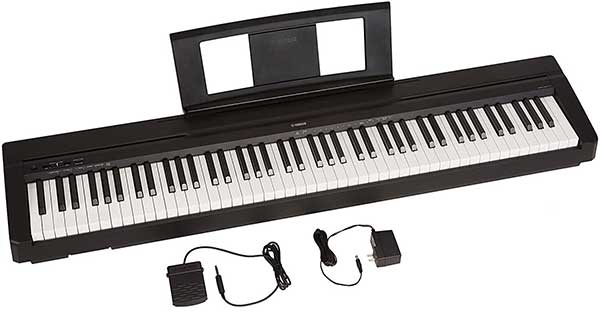
| Estimated Price | $450 |
| Weight | 25 pounds |
| Size Dimensions | 58.2” x 16.1” x 11.7” |
| Keys | 88-key weighted keyboard with Graded Hammer Standard action |
| Touch Sensitivity | Four touch sensitivity level |
| Polyphony | 64 notes |
My Review: This full-sized keyboard features fully-weighted keys and rich, vibrant piano tones at an affordable price. It doesn’t come with a lot of extra features, which may be a deterrent for some buyers, but if you’re looking for a solid instrument to learn or practice on, the Yamaha P71 is a good option. This digital piano will give you a good playing experience and quality sound, and if you’re looking to eventually move to an acoustic piano, the weighted keys will help build and develop your finger strength. This model is very similar to the Yamaha P-45 but comes at a better price.
Who Will Use This Most: The Yamaha P71 keyboard piano is best suited for beginners or those looking for a compact instrument to practice on. It’s cost-effective and offers the features needed to provide an authentic acoustic piano experience. Beginners who learn on this keyboard piano will find it easy to transfer to an acoustic piano when they’re ready.
Bottom Line: This is a great digital piano for beginners or those who are looking for an instrument to practice on. This keyboard piano may not have a lot of extra features but is an affordable, easy-to-use option that features weighted keys and natural piano tones.
13. Roland GO:PIANO88
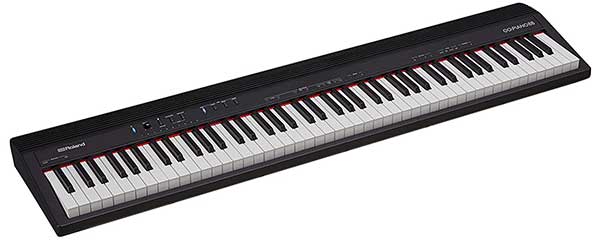
| Estimated Price | $400 |
| Weight | 15.4 pounds |
| Size Dimensions | 50.56” x 11.5” x 3.43” |
| Keys | 88-key keyboard |
| Touch Sensitivity | Three touch sensitivity level |
| Polyphony | 128 notes |
My Review: The Roland GO:PIANO88 keyboard piano is designed for musicians on the go. This is a great instrument for experienced players looking for a compact and portable second instrument or for aspiring musicians looking to develop their skills. Featuring a fully wireless operation through its optional battery power and Bluetooth connectivity, you can use this instrument from almost anywhere. Weighing only 15.5 pounds, this keyboard piano is one of the lightest on our list and is extremely portable. The biggest drawbacks to this instrument are its lack of fully weighted keys and its limited voices (it only offers four). If you’re not looking for fully-weighted keys and are primarily interested in piano tones, this is a great option and worth checking out.
Who Will Use This Most: This is a great first keyboard piano for aspiring musicians. Whether you’ve just booked your first gig and need a portable instrument, or you need a second instrument to take back and forth from sessions, the Roland GO:PIANO88 will meet your needs. Featuring Bluetooth connectivity and fully wireless operation through battery power, this keyboard piano significantly reduces set up and breakdown time. It also includes a built-in recorder so that you’re able to capture session ideas easily.
Bottom Line: The Roland GO:PIANO88 is a great keyboard piano for beginners and on-the-go musicians. It’s not stacked with features but does offer a fully wireless operation and is extremely portable.

14. Artesia PE-88
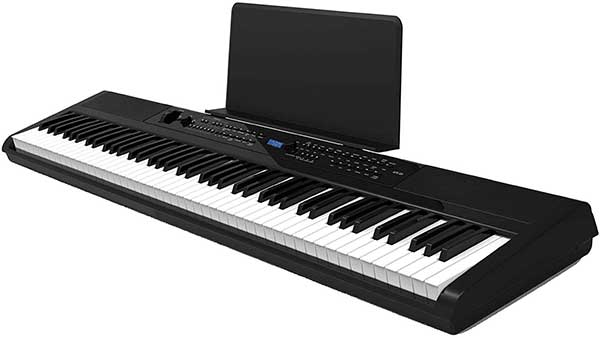
| Estimated Price | $300 |
| Weight | 19 pounds |
| Size Dimensions | 55.5” x 14.5” x 7.5” |
| Keys | 88-key semi-weighted keyboard with spring action |
| Touch Sensitivity | Five touch sensitivity option |
| Polyphony | 64 notes |
My Review: The Artesia PE-88 is a solid beginner keyboard piano that features great connectivity options. This full-sized digital piano features semi-weighted keys with five touch sensitivity options and over 130 sounds and instrument tones with solid sound quality. It also has a built-in two-track MIDI recorder as well as a microphone input with volume control, which are great features for gig musicians. If you’re looking for a good stage or studio keyboard piano at a low cost, this instrument is a great option.
Who Will Use This Most: The Artesia PE-88 is a great choice for aspiring musicians who are looking for an instrument to take back and forth from gigs and sessions. With great built-in connectivity options, over 130 tones and sounds, and onboard two-track recorder, this digital piano offers everything you need to get started as a gig performer at an extremely reasonable cost.
Bottom Line: A cost-effective option for musicians who are just starting out. This keyboard piano has great connectivity features, solid sound, and is compact and portable. If you’re looking for the best budget keyboard piano this should be a top contender.

15. Artesia Performer

| Estimated Price | $210 |
| Weight | 19 pounds |
| Size Dimensions | 50” x 11” x 3.25” |
| Keys | 88-key semi-weighted keyboard with spring tension action |
| Touch Sensitivity | 5 Levels + Fixed |
| Polyphony | 32 notes |
My Review: The Artesia Performer is a great keyboard for beginners, especially those who haven’t played with weighted keys before. It’s a great instrument for those looking to make the transition from unweighted to fully weighted keys. This user-friendly keyboard is perfect for musicians looking to learn piano due to its compatibility with most music apps and learning software. If you’re looking for a cost-effective instrument to learn on, the Artesia Performer is a great choice.
Who Will Use This Most: This keyboard piano is ideal for beginners who are just starting out or are looking to make the transition from unweighted to fully weighted keys. This keyboard offers the right features to help beginners get started, is portable, and very easy to use.
Bottom Line: The Artesia Performer is designed for beginner pianists looking to improve their skills. It’s easy to use, cost-effective, and portable. As you develop your skills, you will outgrow this keyboard piano, but it’s a great starting instrument.

16. Roland GO:KEYS

| Estimated Price | $330 |
| Weight | 8.6 pounds |
| Size Dimensions | 34.5” x 10.7” x 3.2” |
| Keys | 61-key unweighted keyboard |
| Touch Sensitivity | Three levels of touch sensitivity |
| Polyphony | 128 notes |
My Review: This fun, user-friendly keyboard piano is a great choice for aspiring musicians looking to try their hand at songwriting and production. This music creation keyboard includes a Loop Mix function that allows you to create full tracks through looped sounds. While it’s price point puts it in line with many other beginner keyboard pianos, this instrument is not necessarily the best choice for outright beginners due to the number of features it offers (this can be overwhelming when learning). The Roland GO:KEYS offers great functionality for intermediate and expert players looking to develop composition and production skills with a fun, intuitive instrument.
Who Will Use This Most: While this may be a tempting option for beginners, especially at its reasonable price point, the Roland GO:KEYS keyboard is best suited for intermediate and experienced players who are looking to develop production and songwriting skills. You can have a lot of fun with this keyboard, but the many features may be distracting for a beginner who is trying to learn the basics. This keyboard also leans more into the synthesizer realm, so it’s not the best option for someone who is strictly looking to learn and play the piano.
Bottom Line: This keyboard is a lot of fun and gives experienced players the chance to dip their toes into the songwriting and arrangement sides of the musical world. The Roland GO:KEYS offers a lot of bang for its buck, you can expect to have a good time with this instrument.

17. Yamaha PSR-EW300
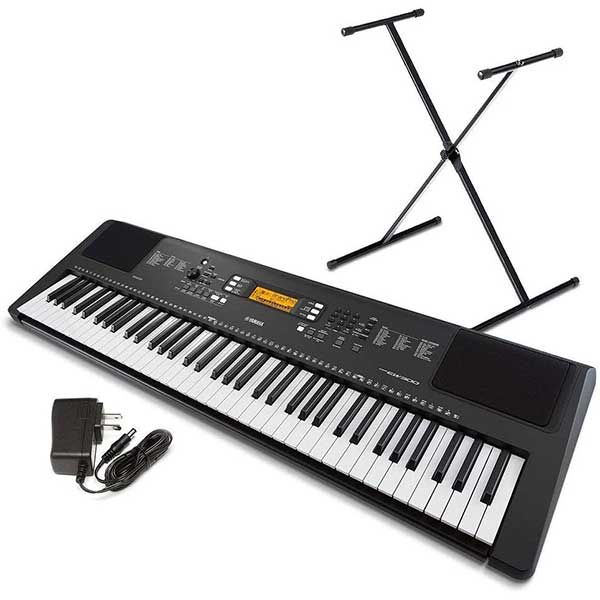
| Estimated Price | $270 |
| Weight | 13 pounds |
| Size Dimensions | 45.37” x 4.62” x 14.5” |
| Keys | 76-key unweighted keyboard |
| Touch Sensitivity | Touch-sensitive key |
| Polyphony | 48 notes |
My Review: The Yamaha PSR-EW300 is a great option for musicians of all skill levels. It’s a great option for beginners looking to develop their skills and features 154 onboard songs to practice with and Yamaha Education Suite (Y.E.S.), which will help you learn basic piano fundamentals and music theory. For more advanced players, this keyboard piano has great connectivity and an incredible library of instrument voices and rhythm styles. The main drawback to this model is its lack of weighted keys, but Yamaha makes up for this by making the keys touch-sensitive, meaning the harder you press on a key the louder it sounds and vice versa. Overall this keyboard piano is a solid option for serious beginners looking to develop their skills.
Who Will Use This Most: The Yamaha PSR-EW300 is best suited for serious beginners looking to develop their skill set. It has enough features and functionality that you won’t outgrow it quickly, and its onboard learning system will help you learn the basic techniques of piano playing. Intermediate and experienced pianists can get good use out of this instrument as well but may be disappointed by the lack of weighted keys.
Bottom Line: A great option for beginners, this keyboard piano has all the functions and features you need to develop your skillset and learn basic fundamentals. This is a good, affordable instrument that delivers great value. This is easily one of the best cheap piano keyboards out there.

18. Casio WK-245
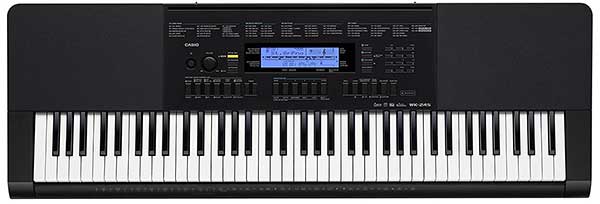
| Estimated Price | $230 |
| Weight | 23 pounds |
| Size Dimensions | 50” x 7” x 18” |
| Keys | 76-key unweighted keyboard |
| Touch Sensitivity | Touch Sensitive key |
| Polyphony | 48 notes |
My Review: While this keyboard is primarily designed for beginners or those looking to improve their skills, the Casio WK-245 offers plenty of onboard features to meet the needs of more experienced players. This keyboard piano is classified as an “arranger keyboard” and includes features like a built-in six-track recorder, onboard mic and audio input, and onboard sampling that allow you to compose and create to your heart’s desire. While not a full-sized keyboard, the Casio WK-245 has 76 touch-sensitive keys, includes 600 built-in sounds, and 180 rhythms that you can play along with. The biggest drawback in my opinion is the unweighted keys, but many musicians are not bothered by this. This is a great, affordable option for those looking to dip their toes into piano and want to play around with additional sounds.
Who Will Use This Most: If you’re looking to dive into the world of composition and songwriting, this is a great keyboard piano to consider. Its features are designed for those looking to expand their musical creativity and try their hand at arranging. The Casio WK-245 is also a great option for beginners who are looking to dip their toes into piano without sinking a lot of money into their first instrument.
Bottom Line: A solid keyboard piano with plenty of features to keep you creating. The only downsides to this model are its lack of unweighted keys and the fact it’s not a full-sized keyboard (only 76-keys).
Choosing the Right Budget Keyboard Piano (Buying Guide)
Before purchasing your instrument, you need to decide if you’re looking for a digital piano strictly for home use or if you’re looking for an instrument that can be used in performances. If you’re looking for a keyboard piano to strictly use for practice at home, then you’ll be less concerned with connectivity options and portability. If you’re looking for a keyboard you can take to gigs or back and forth to writing sessions, you’ll need to look for a model that is compact, portable, and includes the connectivity features you need for performances. Stage keyboard pianos tend to be a bit pricer as they often include more features and better connectivity than pianos intended for practice and home use. There are several affordable models that can function well for both purposes, but before you begin your buying journey it’s important to have an idea of what features and connectivity you’ll need to achieve your goals.
Buying a keyboard piano of any kind is an investment and finding the right keyboard piano for your budget can feel challenging. With all the options available to you, it can be hard to narrow down which keyboard will give you the best value for your dollar. Whether you’re a first-time buyer looking to find a great keyboard piano to start off with or you’re an experienced musician looking for the right digital piano in your budget, it can be difficult to know what features to look for and which keyboards offer the best value. Here are some features you should look for when choosing a keyboard piano for your needs.
Keyboard Piano vs. Synthesizer
Many newer piano players tend to gravitate towards synthesizers when they’re looking to purchase their first keyboard. While synthesizers are compact, portable, and typically cost less than a full-sized keyboard piano, they’re not the best option for musicians looking for a true piano experience. Synthesizers typically don’t have weighted keys, which is an important feature for those looking to replicate the acoustic piano experience. Synthesizers also come with a lot of extra features that you won’t use if you’re simply looking to develop your piano playing abilities. Keyboard pianos are designed to provide a playing experience that replicates that of an acoustic piano and are the best choice for those looking to mimic that experience.
Full-Sized Keyboard
If you want to have a true acoustic piano experience, look for a full-sized keyboard piano. A full-sized keyboard features 88 keys and seven full octaves. Comprised of 52 white keys and 36 black keys, a full-sized keyboard piano will provide you the opportunity to play music that is both above and below the middle staff. As a piano player, I will always prefer a full-sized keyboard to any other option. Full-sized keyboards are also important if you plan to play classical or jazz music, but you can get away with fewer keys if you’re primarily interested in rock or pop music.
If you find the size or cost of a full-sized keyboard prohibitive, look for a keyboard piano that has at least five octaves or 61 keys. A five-octave keyboard will still give you the freedom to play what you like at a smaller size and for a lower cost.
Weighted Keys
As a piano player myself, this is, in my opinion, probably the most important feature to look for when choosing your keyboard piano. Keys on traditional acoustic pianos have weight to them due to the fact that they’re attached to a lever that causes a hammer to strike the piano strings and in turn emits sound. Weighted keys replicate this tension to give you the same playing experience you’d have with an acoustic piano. The feel of weighted keys makes a huge difference when you’re focused on dynamics and playing with expression. While it’s possible to achieve the same effects without weighted keys, it won’t give you the same feeling of playing an acoustic piano and will detract from the authentic piano experience.
Action
There are a variety of action options available across keyboard piano models. My personal preference is a weighted action – mentioned above – as this option will give you the closest acoustic piano experience. Other options include semi-weighted, synth, and hammer action. Each of these actions will offer a different feel when playing. A semi-weighted action will feel similar to playing an acoustic piano without the full tension a weighted action offers, and hammer action goes one step further to mimic the acoustic piano feel by including mechanical hammers that will further enhance your playing experience. Synth-action or unweighted keys feel more like organ keys and don’t have the same resistance the other actions have when pushed down. If you’re looking for a keyboard piano that feels closest to an acoustic piano hammer, weighted, or semi-weighted actions are the right choice for you. Choosing the right action will come down to personal preference and if you’re not sure what you’re looking for I recommend trying out keyboard models with different actions to see what feels best for you.
Touch Sensitivity and Responsiveness
Touch sensitivity is a feature that equates the sound emitted from your keyboard with the pressure you place on the keys: the harder a key is pressed, the louder the sound, and the lighter a key is pressed, the softer the sound. Not all keyboard pianos include a touch sensitivity or responsiveness feature, but touch sensitivity will allow you to place more emphasis on dynamic and add more character and emotion to your music.
Key Size
You’ll want to make sure the keys on your digital piano are standard size so that you’re able to sit down to any keyboard or acoustic piano and play comfortably. Most keyboards come with standard piano keys, but some of the lower-cost options feature narrow keys, which make it harder to move between instruments.
Sound
If you’re looking for a keyboard piano that provides a true piano experience, you’ll want to find a model that has a realistic, high-quality piano sound. Most keyboard brands produce quality sounds that are equivalent to those produced by an acoustic piano, but some lower-cost options might sound brassy or tinny rather than delivering a natural piano sound. Sound is a highly subjective feature, so it’s important to look into different brands to see which sound appeals to you. I always recommend testing a keyboard piano out before purchasing it to ensure that it has the sound quality you’re looking for. If you’re purchasing your keyboard online, be sure to look at online reviews or demos to see if the model you’re looking at has the sound quality you want.
If you’re interested in utilizing other instrument tones outside of acoustic piano, most keyboards will come with additional instrument voices. Some of the instrument tones I commonly use aside from acoustic piano are electric piano, electric bass, acoustic bass, and acoustic guitar. If you know there are specific sounds you’d like to have access to through your keyboard piano, be sure to research the various voices available on each model you’re considering.
Pedals
For those that are looking to replicate an acoustic piano experience, it’s important to choose a keyboard piano that comes with a pedal or, at the very least, has a port designed to accommodate a pedal. The most important pedal for a true piano experience is called a sustain pedal, which allows notes to continue sounding after you’ve moved on to other notes. The sustain pedal will give you a similar effect as the damper pedal on acoustic pianos. This pedal is used often in most forms of piano playing, especially modern music. If the keyboard piano you purchase does not include a sustain pedal, make sure to find one that is compatible with your keyboard model.
Polyphony
Polyphony is the number of notes a keyboard piano can sound at one time, meaning the number of notes you can play simultaneously. For example, if you wanted to play 64 notes all at once, you’d need a keyboard with at least a polyphony of 64.
Adjustable Stand
This may seem like an obvious feature, but most keyboard pianos will require an adjustable stand. If the keyboard you’re interested in does not come with a stand, make sure to purchase one, otherwise, you’ll be playing your new digital piano on the floor or from your dining room table.
Hard or Soft Case
This might seem like another obvious accessory for your keyboard, but many people often forget to make this purchase. If your keyboard piano does not come with a hard or soft case, be sure to purchase one that will fit your model. This accessory is especially important if you plan to play live shows as you’ll need a safe way to transport and store your instrument.
Bonus Features
The following features are not essential but can enhance your playing experience and give you the opportunity to expand beyond traditional piano playing.
MIDI Compatibility
MIDI stands for “musical instrument digital interface” and is a communication protocol between electronic instruments and computers. MIDI compatibility is important if you plan to connect your keyboard with your computer and use it as a digital workstation or are interested in pursuing electronic music.
Input/Output
The audio input and output sections of your keyboard piano can be important features depending on your musical goals. If your goal is to play live music, you’ll definitely need audio outputs to connect external amplifiers, mixers, or speakers. Many keyboards will not come with audio inputs as most rely on MIDI, but, depending on your goals, this may be a feature to keep in mind when choosing your instrument.
Multitimbrality
Multitimbrality is the ability to play multiple sounds at once. Multitimbrality can be used to create a background accompaniment to support the main melody or if you’re looking to build out a fuller track through a single instrument. This is another feature to look into if you’re looking to use your keyboard piano to create music outside of standard piano playing.
Split Capability
Some keyboard pianos give you the option to split the keyboard into two halves and give each half its own designated sound (e.g the left hand will play the electric bass while the right hand will play the electric piano). While this is not an essential feature by any means, it’s a great bonus that allows you to focus the bass line in your left hand while playing the melody or chords in your right hand in a different instrument or sound.
Duo/Duet Mode
Duo or Duet Mode (also sometimes called Lesson Mode) gives you the ability to split your keyboard into two equal ranges. Not a necessary feature by any means, but a great option if you’re a beginner and plan to take lessons.
Wrap Up
There’s a lot that goes into choosing a keyboard piano and it is all about finding the instrument that’s best for you. While there are a lot of great instruments on this list, the best keyboard piano is for you is the one that best suits your needs. Before you make a purchase, it’s important to test any instrument you’re considering. Even if you’re planning to buy your keyboard online, I would recommend taking the time to stop in at your local music shop and test different types of keyboards from different manufacturers and decide which one you like best. If you’re not able to test the keyboard your most interested in, I would take the time to watch and read online reviews.
You should also take the time to consider what your musical goals are. Are you looking for a practice instrument to learn on? Do you hope to eventually play live shows? Are you looking for a portable instrument that will replicate the acoustic piano experience? Are you looking for a second instrument that’s gig-friendly and easy to move? Knowing the answers to questions like these will help you make the best choice and choose an instrument that you can use for a long period of time.

My name is Chris and I’ve had a passion for music and guitars for as long as I can remember. I started this website with some of my friends who are musicians, music teachers, gear heads, and music enthusiasts so we could provide high-quality guitar and music-related content.
I’ve been playing guitar since I was 13 years old and am an avid collector. Amps, pedals, guitars, bass, drums, microphones, studio, and recording gear, I love it all.
I was born and raised in Western Pennsylvania. My background is in Electrical Engineering, earning a Bachelor’s degree from Youngstown State University. With my engineering experience, I’ve developed as a designer of guitar amplifiers and effects. A true passion of mine, I’ve designed, built, and repaired a wide range of guitar amps and electronics. Here at the Guitar Lobby, our aim is to share our passion for Music and gear with the rest of the music community.

I cannot thank you enough for such great writing and up-to-the-point reviews.
Thanks for such interesting and knowledgeable stuff. I simply love to follow you and every writing here.